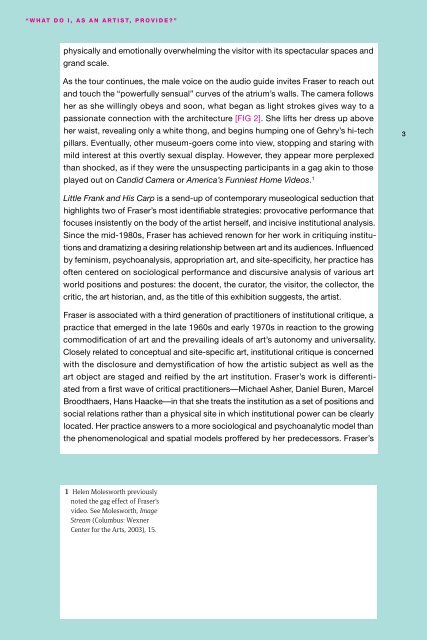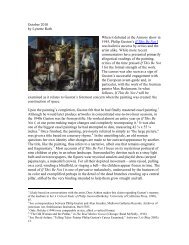Andrea Fraser, “What do I, as an artist, provide?” - Kemper Art Museum
Andrea Fraser, “What do I, as an artist, provide?” - Kemper Art Museum
Andrea Fraser, “What do I, as an artist, provide?” - Kemper Art Museum
Create successful ePaper yourself
Turn your PDF publications into a flip-book with our unique Google optimized e-Paper software.
“ W h at d o I , a s a n a r t i s t, p r o v i d e ? <strong>”</strong><br />
physically <strong>an</strong>d emotionally overwhelming the visitor with its spectacular spaces <strong>an</strong>d<br />
gr<strong>an</strong>d scale.<br />
As the tour continues, the male voice on the audio guide invites <strong>Fr<strong>as</strong>er</strong> to reach out<br />
<strong>an</strong>d touch the “powerfully sensual<strong>”</strong> curves of the atrium’s walls. The camera follows<br />
her <strong>as</strong> she willingly obeys <strong>an</strong>d soon, what beg<strong>an</strong> <strong>as</strong> light strokes gives way to a<br />
p<strong>as</strong>sionate connection with the architecture [FIG 2]. She lifts her dress up above<br />
her waist, revealing only a white thong, <strong>an</strong>d begins humping one of Gehry’s hi-tech<br />
pillars. Eventually, other museum-goers come into view, stopping <strong>an</strong>d staring with<br />
mild interest at this overtly sexual display. However, they appear more perplexed<br />
th<strong>an</strong> shocked, <strong>as</strong> if they were the unsuspecting particip<strong>an</strong>ts in a gag akin to those<br />
played out on C<strong>an</strong>did Camera or America’s Funniest Home Videos. 1<br />
<br />
Little Fr<strong>an</strong>k <strong>an</strong>d His Carp is a send-up of contemporary museological seduction that<br />
highlights two of <strong>Fr<strong>as</strong>er</strong>’s most identifiable strategies: provocative perform<strong>an</strong>ce that<br />
focuses insistently on the body of the <strong>artist</strong> herself, <strong>an</strong>d incisive institutional <strong>an</strong>alysis.<br />
Since the mid-1980s, <strong>Fr<strong>as</strong>er</strong> h<strong>as</strong> achieved renown for her work in critiquing institutions<br />
<strong>an</strong>d dramatizing a desiring relationship between art <strong>an</strong>d its audiences. Influenced<br />
by feminism, psycho<strong>an</strong>alysis, appropriation art, <strong>an</strong>d site-specificity, her practice h<strong>as</strong><br />
often centered on sociological perform<strong>an</strong>ce <strong>an</strong>d discursive <strong>an</strong>alysis of various art<br />
world positions <strong>an</strong>d postures: the <strong>do</strong>cent, the curator, the visitor, the collector, the<br />
critic, the art histori<strong>an</strong>, <strong>an</strong>d, <strong>as</strong> the title of this exhibition suggests, the <strong>artist</strong>.<br />
<strong>Fr<strong>as</strong>er</strong> is <strong>as</strong>sociated with a third generation of practitioners of institutional critique, a<br />
practice that emerged in the late 1960s <strong>an</strong>d early 1970s in reaction to the growing<br />
commodification of art <strong>an</strong>d the prevailing ideals of art’s autonomy <strong>an</strong>d universality.<br />
Closely related to conceptual <strong>an</strong>d site-specific art, institutional critique is concerned<br />
with the disclosure <strong>an</strong>d demystification of how the <strong>artist</strong>ic subject <strong>as</strong> well <strong>as</strong> the<br />
art object are staged <strong>an</strong>d reified by the art institution. <strong>Fr<strong>as</strong>er</strong>’s work is differentiated<br />
from a first wave of critical practitioners—Michael Asher, D<strong>an</strong>iel Buren, Marcel<br />
Broodthaers, H<strong>an</strong>s Haacke—in that she treats the institution <strong>as</strong> a set of positions <strong>an</strong>d<br />
social relations rather th<strong>an</strong> a physical site in which institutional power c<strong>an</strong> be clearly<br />
located. Her practice <strong>an</strong>swers to a more sociological <strong>an</strong>d psycho<strong>an</strong>alytic model th<strong>an</strong><br />
the phenomenological <strong>an</strong>d spatial models proffered by her predecessors. <strong>Fr<strong>as</strong>er</strong>’s<br />
1 Helen Molesworth previously<br />
noted the gag effect of <strong>Fr<strong>as</strong>er</strong>’s<br />
video. See Molesworth, Image<br />
Stream (Columbus: Wexner<br />
Center for the <strong>Art</strong>s, 2003), 15.




